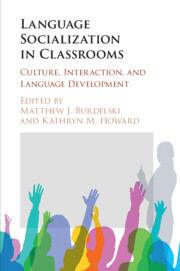Book contents
- Language Socialization in Classrooms
- Language Socialization in Classrooms
- Copyright page
- Dedication
- Contents
- Figures
- Tables
- Contributors
- Acknowledgments
- Transcription Conventions
- 1 Introduction
- Part I Socializing Values, Dispositions, and Stances
- Part II Socializing Identities
- 5 Learning to Be a Poet
- 6 Teaching Words, Socializing Affect, and Social Identities
- 7 Making the Familiar Change
- 8 Negotiating Epistemic Authority and Co-Constructing Difference
- Part III Language Socialization and Ideology
- Part IV Conclusion
- Index
- References
8 - Negotiating Epistemic Authority and Co-Constructing Difference
Socializing “Nonnative Speaker” Teachers in a US Graduate Program in TESOL
from Part II - Socializing Identities
Published online by Cambridge University Press: 10 February 2020
- Language Socialization in Classrooms
- Language Socialization in Classrooms
- Copyright page
- Dedication
- Contents
- Figures
- Tables
- Contributors
- Acknowledgments
- Transcription Conventions
- 1 Introduction
- Part I Socializing Values, Dispositions, and Stances
- Part II Socializing Identities
- 5 Learning to Be a Poet
- 6 Teaching Words, Socializing Affect, and Social Identities
- 7 Making the Familiar Change
- 8 Negotiating Epistemic Authority and Co-Constructing Difference
- Part III Language Socialization and Ideology
- Part IV Conclusion
- Index
- References
Summary
This chapter explores the expert–novice construct through an investigation of classroom discourse focusing on four international graduate students in an MA program in TESOL at a US university. It examines the contingent and shifting nature of expert–novice in two teaching methods courses, which were situated at a nexus of multiple communities of practice: the classrooms, the program, graduate school, the TESOL profession, etc. Microanalysis of classroom interactions reveals how instructors ascribed knowledge to students and positioned them along a continuum of expertise, and considers how focal students’ identities as nonnative speakers of English shaped this positioning. Classroom practices are juxtaposed against focal students’ self-representations as displayed in interviews and classroom behavior as they validated, resisted, or negotiated their positioning. The chapter reflects on the impact of these expert–novice identifications on focal students’ socialization as well as implications of a more dynamic and fluid conceptualization of expert–novice for the study of academic discourse socialization.
- Type
- Chapter
- Information
- Language Socialization in ClassroomsCulture, Interaction, and Language Development, pp. 158 - 178Publisher: Cambridge University PressPrint publication year: 2020
References
- 3
- Cited by

